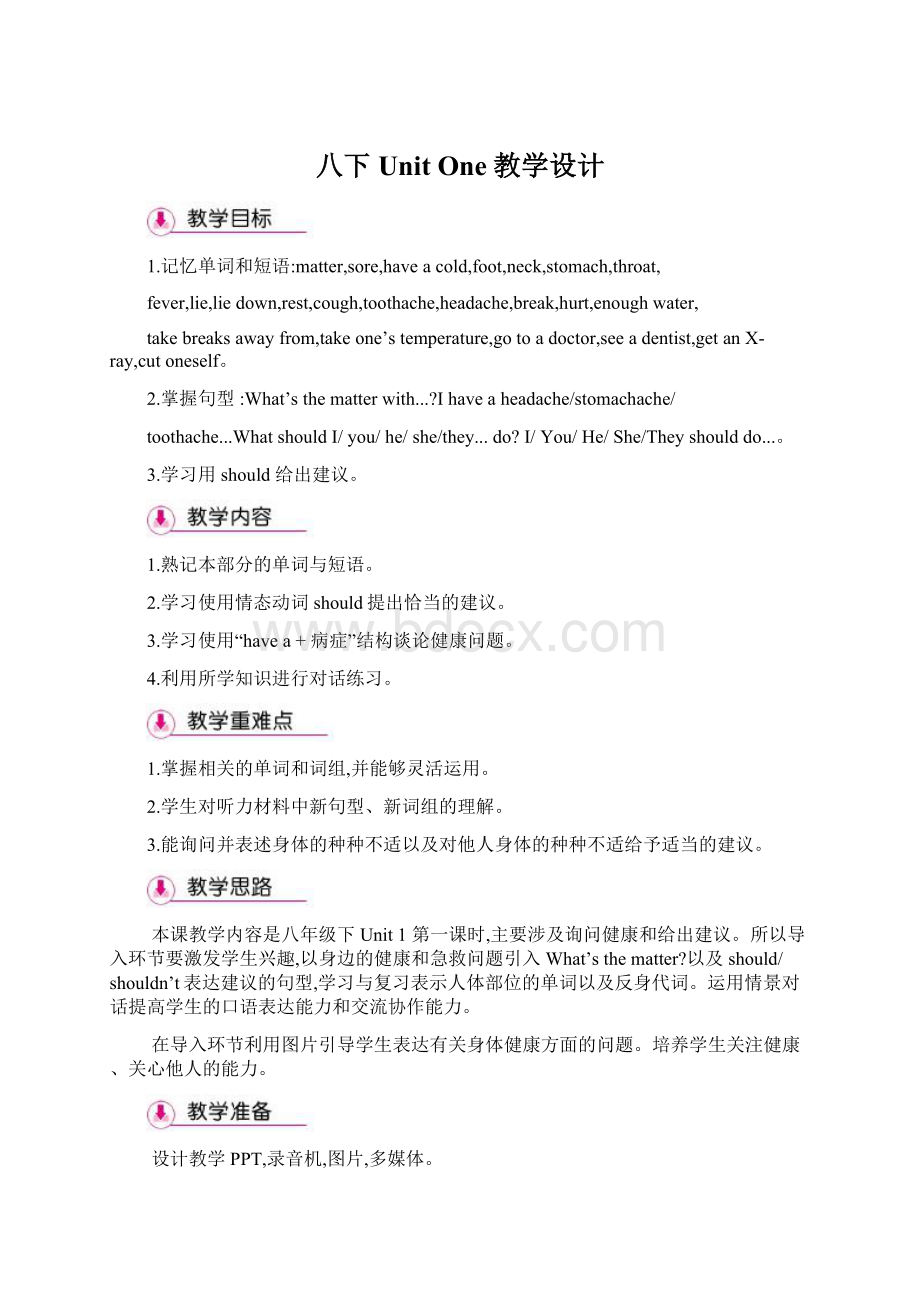八下Unit One教学设计.docx
《八下Unit One教学设计.docx》由会员分享,可在线阅读,更多相关《八下Unit One教学设计.docx(11页珍藏版)》请在冰豆网上搜索。

八下UnitOne教学设计
1.记忆单词和短语:
matter,sore,haveacold,foot,neck,stomach,throat,
fever,lie,liedown,rest,cough,toothache,headache,break,hurt,enoughwater,
takebreaksawayfrom,takeone’stemperature,gotoadoctor,seeadentist,getanX-ray,cutoneself。
2.掌握句型:
What’sthematterwith...?
Ihaveaheadache/stomachache/
toothache...WhatshouldI/you/he/she/they...do?
I/You/He/She/Theyshoulddo...。
3.学习用should给出建议。
1.熟记本部分的单词与短语。
2.学习使用情态动词should提出恰当的建议。
3.学习使用“havea+病症”结构谈论健康问题。
4.利用所学知识进行对话练习。
1.掌握相关的单词和词组,并能够灵活运用。
2.学生对听力材料中新句型、新词组的理解。
3.能询问并表述身体的种种不适以及对他人身体的种种不适给予适当的建议。
本课教学内容是八年级下Unit1第一课时,主要涉及询问健康和给出建议。
所以导入环节要激发学生兴趣,以身边的健康和急救问题引入What’sthematter?
以及should/shouldn’t表达建议的句型,学习与复习表示人体部位的单词以及反身代词。
运用情景对话提高学生的口语表达能力和交流协作能力。
在导入环节利用图片引导学生表达有关身体健康方面的问题。
培养学生关注健康、关心他人的能力。
设计教学PPT,录音机,图片,多媒体。
StepⅠ.Leadin
Leadingin【情景1】
1.Playasong“Ifyouarehappy”forallthestudentstosing.
Whilesinging,touchthepartthatismentionedinthesong.(clapyourhands,stampyourfeet,winkyoureyes)
Thensingthesongandaddupotherparts—Ifyouarehappyandyouknowit,shakeyourhead,openyourmouth,liftupyourleg,liftupyourarm...etc.
Andtheteacher(T)showsthepicturesaboutbodypartsontheblackboard.
2.T:
NowhaveyoumasteredalltheEnglishnamesofourbodyparts?
Let’scometo1atocheck.Pleaselookatthepictureonpage1.Writethecorrectletter[a-m]foreachpartofthebody.
arm back
ear eye
foot hand
head leg
mouth neck
nose stomach
tooth
[设计意图] 以学生熟悉的拍手歌开始本节课的教学,让学生在唱歌的同时完成对身体部位单词的认知,并通过对歌曲的改编联系更多的有关身体部位的单词。
在开始新课前创设比较活泼轻松的学习氛围,激发学生的学习热情,为下面的教学做好铺垫。
Leadingin【情景2】
1.T:
Areyouhappy?
S:
Yes,weare.
T:
Whenwe’rehappy,wecanclapourhandsandstampourfeet.Handsandfeetarepartsofourbody;doyouknowotherpartsofourbodyinEnglish?
2.Teachthepartsofthebodyonebyonebytouchingit.Whileteachingone,letthemtouchorshowit.PresentapictureofababyandYaoMing.Letthestudentssaythepartsofthebody.
T:
NowhaveyoumasteredalltheEnglishnamesofourbodyparts?
Let’scometo1atocheck.Pleaselookatthepictureonpage1.Writethecorrectletter[a-m]foreachpartofthebody.
arm back
ear eye
foot hand
head leg
mouth neck
nose stomach
tooth
【Keys】 harm eback gear ieye bfoot
ahand jhead lleg cmouth dneck mnosekstomach ftooth
[设计意图] 以对话加图片的形式询问身体部位,学生比较感兴趣,导入本节所学身体部位的词汇,顺利导入新授内容。
StepⅡ.Presentation
T:
Ifyouareadoctor,howdoyouaskyourpatientswhenyouseethem?
Let’slookatthefollowingpictures.
A:
What’sthematter?
B1:
Ihaveacold.
A:
What’sthematter?
B2:
Ihaveastomachache.
A:
What’sthematter?
B3:
Ihaveasoreback.
Thefollowinglanguagepointsshouldbeexplained.
☆教材解读☆
1.What’sthematter?
本句是对某人患有疾病的询问,相当于What’sthetrouble(withyou)?
/What’swrong(withyou)?
/Whatseemstobethetrouble?
“你哪儿不舒服/怎么了?
”。
—What’sthematterwithyou?
你怎么了?
—Ihaveatoothache.我牙疼。
2.Ihaveacold.
haveacold表示“感冒”,相当于catchacold,修饰患重感冒用bad。
注意后者catchacold不能和表示“一段时间”的状语连用。
Ihad/caughtabadcoldlastweek.
上周我得了一场重感冒。
3.Ihaveastomachache.
stomachachen.胃痛;腹痛。
stomach胃;腹部。
“have/hasa+病痛的名词”表示“患某种病”。
Hehasastomachache.他胃痛。
【拓展】 患病的相关短语:
haveastomachache胃痛;haveafever发烧;haveaheadache头痛;haveasorethroat喉咙疼;haveatoothache牙痛;haveacough咳嗽。
【辨析】 sore,ache,pain
(1)sore指因发炎引起的疼痛,是形容词,用以修饰名词。
常用结构为“haveasore+身体部位”。
Shehasasoreback.她背疼。
(2)ache常与身体部位名词构成合成词,指某部位疼痛。
常用结构为“havea+身体部位-ache”。
Ihaveatoothache.我牙痛。
(3)pain指身体某部位疼痛。
常用结构为“have/feelapaininthe/one’s+身体部位”。
Shefeltapaininherstomach.
她感到胃疼。
[设计意图] 创设对话实景,模拟医患用语,为下面教学做准备。
StepⅢ.Listeningpractice
T:
Weallknowtheconversationsareabouthealthproblems.What’sthematterwitheachperson?
Now,listenforthespecificideas.
(1)Listenandlookatthepicture.Thennumberthenames[1-5].
Nancy Sarah
David Ben
Judy
(2)Listenagainandfillintheblanksandrepeat.
Conversation1:
Ididn’tputonmyjacket.NowIhavea .
Conversation2:
What’sthe ?
Iatetoomuchjunkfood.I a .Ialmostcouldn’tgetmyselfoutofbedthismorning.
Conversation3:
Ihurtmyself.NowIhavea .
Conversation4:
Ididn’tsleepwell.Ihavea .Ican’treallyeat either.
Conversation5:
Italkedtoomuchyesterdayanddidn’tdrinkenoughwater.Ihaveavery now.
【Keys】
(1)31254
(2)Conversation1:
cold2:
matter,got,stomachache3:
soreback4:
toothache,anything5:
sorethroat
[设计意图] 通过层层递进的听力任务设计,尽量给学生足够的听的机会。
学生在做听力时,大多数能听清本次听力的材料,听力活动先让学生听大意,然后再听细节,能逐步培养学生用听的技能获取、处理和传递所需信息的能力。
StepⅣ.Pairwork
Lookatthepictures.Whatarethestudents’problems?
Makeconversationslikethis:
A:
What’sthematterwithJudy?
B:
Shetalkedtoomuchyesterdayanddidn’tdrinkenoughwater.Shehasaverysorethroatnow.
[设计意图] 以问答的方式对话练习要点句型,锻炼学生的口头表达能力。
StepⅤ.Listeningpractice(2a-2c)
Task1:
Listenandnumberthepictures[1-5]intheorderyouhearthem.
Task2:
Listentothetapeandfindoutthegeneralideaoftheconversations.
Thegeneralideaoftheconversationsisabout .
A.studyproblems
B.healthproblems
C.healthproblemsandadvice
Task3:
Listenandmatchtheproblemswiththeadvice.(听取细节)
1.fever a.liedownandrest
2.stomachacheb.drinksomehotteawithhoney
3.coughandsorethroatc.seeadentistandgetanX-ray
4.toothached.takeyourtemperature
5.cutmyselfe.putsomemedicineonit
Task4:
Gothroughtheblanksplease.Thenlistenandcompletetheconversationsaccordingtothetape.(听后活动)
Conversation
(1):
Girl2:
Myheadfeelsveryhot.
Girl1:
Youshould .
Conversation
(2):
Girl2:
Ihavea anda .
Girl1:
Youshoulddrinksomehottea honey.
Conversation(3):
Boy:
Ihavea .
Girl:
Youshouldn’teatsomuchnexttime.Now,youshould andrest.
Conversation(4):
Boy:
Ihaveatoothache.
Girl:
Youshould adentistand anX-ray.
Conversation(5):
Girl2:
I myselfby .
Girl1:
Youshouldputsomemedicineonit.
Task5:
Pairwork
Makeconversationsusingtheinformationin2aand2blikethis:
A:
What’sthematter?
B:
Myheadfeelsveryhot.
A:
Maybeyouhaveafever.
B:
WhatshouldIdo?
A:
Youshouldtakeyourtemperature.
Thefollowinglanguagepointsshouldbeexplained.
☆教材解读☆
1.liedownandrest
liev.躺;平躺。
现在分词是lying。
liedown躺下。
Thedogwaslyingontheground.
狗躺在地上。
【拓展】 lie作动词意为“位于”,相当于is/are,还可意为“说谎,撒谎”。
lie作名词意为“谎言”。
Taiwanlies/istotheeastofFujianProvince.台湾位于福建省的东部。
Don’tbelieveherbecauseshealwayslies.
别信她,因为她总是说谎。
Youarelying,butliescannotcoverupfacts.你在说谎,但谎言掩盖不了事实。
【辨析】 lay,lie
原形
过去式
过去分词
现在分词
layv.产
(卵);下(蛋)
laid
laid
laying
liev.躺;位于
lay
lain
lying
liev.说谎
lied
lied
lying
2.drinksomehotteawithhoney
with说明名词,表示事物的附属部分或所具有的性质,意为“具有,带有,加上,包括……在内”,如“加……的茶水、……馅的包子、水饺”等。
本句中withhoney作hottea的后置定语。
Hedoesn’tliketeawithsugar.
他不喜欢加糖的茶水。
Ilikedumplingswithmeat.
我喜欢肉馅的水饺。
【拓展】 with是介词,表示“和……一起”。
with还表示“带有,有着”,指人随身“长着,戴着,带着……”,还表示人或物的某种特征。
Helikestolivewithhisparents.
他喜欢和父母住在一起。
Chinaisacountrywithalonghistory.
中国是一个有着悠久历史的国家。
Pleasetakeanumbrellawithyou.
请随身带把伞。
【Keys】 Task1:
24315 Task2:
C Task3:
1.d 2.a 3.b 4.c 5.e Task4:
Conversation
(1)takeyourtemperature
(2)cough,sorethroat,with (3)stomachache,liedown (4)see,get (5)cut,accident
[设计意图] 本部分的内容重在培养学生们听寻大意、听寻细节信息和交际的能力。
StepⅥ.Role-playtheconversation(2d)
1.Readtheconversationandanswerthequestions:
(任务题)
(1)What’sthematterwithLisa?
(2)Didshehaveafever?
(3)Whatdidshedoontheweekend?
(4)Whatdoessheneedtodo?
(5)Whatshouldshedonow?
(6)Whatshouldshedoifthingsdon’tgetbetter?
2.Explainsomemainpointsintheconversation.
☆教材解读☆
1.ShouldItakemytemperature?
takeone’stemperature意为“量体温”。
Tomisill.Thedoctoristakinghistemperaturenow.汤姆生病了。
大夫正在给他量体温。
2.Youneedtotakebreaksawayfromthecomputer.
takebreaks表示“休息”,awayfrom表示“远离,不在……”。
Theoldmanenjoyedtheholiday,awayfromthecitynoise.这位老人喜欢度假,远离城市的喧闹。
3.Yeah,IthinkIsatinthesamewayfortoolongwithoutmoving.
◆inthesameway表示“以同样的方式”。
◆fortoolong太长的时间,相当于foralongtime。
for后接一段时间。
Afterwalkingforalongtime,weallgottired.步行了好长时间之后,我们都很疲惫。
◆without作介词,反义词为with,后接名词/代词/动名词形式。
Hewentoutwithoutlockingthedoor.
他没有锁门就出去了。
【拓展】 without用于否定句,表示条件,意为“如果没有”,可与if引导的否定条件状语从句转换。
Wecan’tfinishtheworkwithoutyourhelp.
=Wecan’tfinishtheworkifyoudon’thelpus.如果没有你的帮助,我们就完不成这项工作。
4.Ifyourheadandneckstillhurttomorrow,thengotoadoctor.
hurtv.(使)疼痛;受伤。
hurtoneself自己受伤。
HehurthimselfinP.E.class.
他在体育课上受伤了。
【拓展】 hurtn.伤痛;伤害;创伤。
Theexperienceleftmewithafeelingofdeephurt.这段经历给我心灵上留下了严重的创伤。
【辨析】 hurt,injure
(1)hurt意为“伤害,受伤,疼痛”,一般用语,多指肉体上的伤害、身体某部位的疼痛,也可指对精神或感情方面的伤害。
精神、感情受到创伤多用deeply修饰,身体伤害多用badly修饰。
Thedriverhurtherselfbadlyintheaccident.那位女司机在事故中伤得很重。
Yourwordsdeeplyhurther.
你的话深深伤害了她。
(2)injure意为“损害,伤害”,尤指在事故中受伤。
Heinjuredhiskneeplayingtennis.
他在打网球时膝盖受伤。
3.Readtheconversationaftertheteacher.
4.Practicetheconversationwiththeirpartner.Thenletsomepairsactouttheconversation.
5.Fillintheblanks.
Mandy:
Lisa,areyouOK?
Lisa:
Ihavea andIcan’tmovemyneck.WhatshouldIdo?
ShouldI mytemperature?
Mandy:
No,itdoesn’tsoundlikeyouhavea .Whatdidyoudoontheweekend?
Lisa:
Iplayedcomputergamesallweekend.
Mandy:
That’sprobablywhy.Youneedtotake awayfromthecomputer.
Lisa:
Yeah,IthinkIsatinthesamewayfortoolong moving.
Mandy:
Ithinkyoushould downa